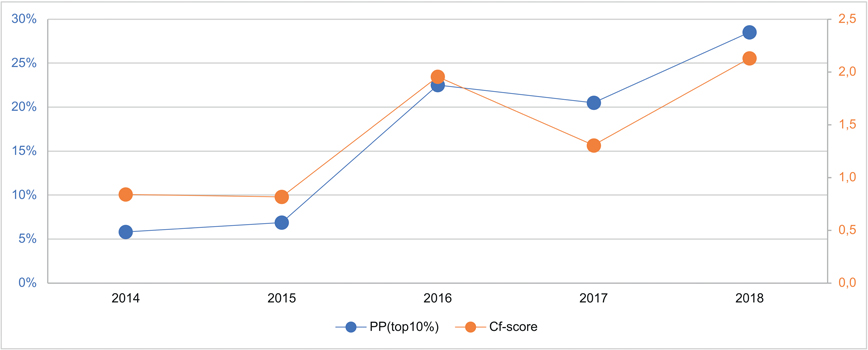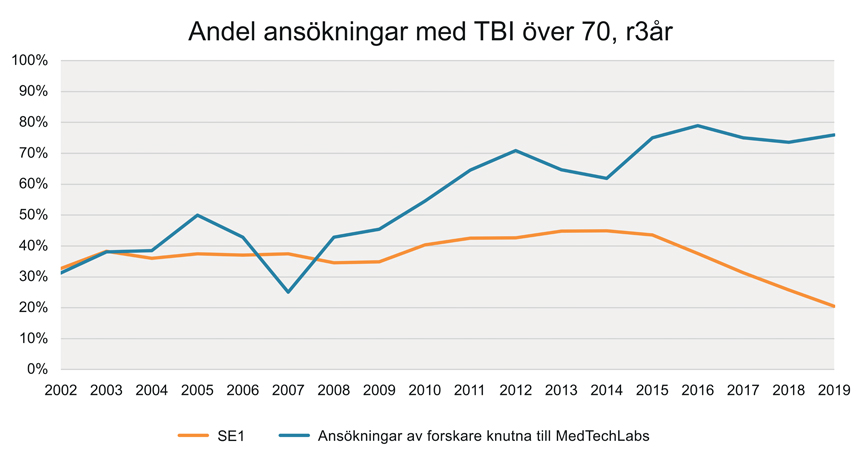Monitoring the quality and innovation of research
The hallmarks of MedTechLabs should be quality, excellence and innovation. Our wish is to attract the best researchers who wants to collaborate on translational research. The fact that our research takes the needs of the healthcare sector as its point of departure provides Region Stockholm with excellent conditions for offering the very best care to tomorrow’s patients.
According to the strategic plan 2021-2026 for MedTechLabs, the goal for the centre is to be among the top ten in the world for medical technology research. To find out the current status, a bibliometric analysis and an analysis of innovative power have been carried out for the MedTechLabs 12 research leaders, which goes back in time until 2020. Read more about the results of these analyses in the MedTechLabs Annual report 2020 (in English).
The analyses have some natural lag but confirm that MedTechLabs has attracted world-class research leaders. Although MedTechLabs was not established until 2018 and two of the research programs were started in 2020, the two analyses provide valuable guidance on future research development. Looking forward, we will continue to follow the development of MedTechLabs and hope to be able to confirm that the key to success in increasingly tough international competition is to continue working in interdisciplinary teams with various cutting-edge competencies.
Quality and impact of research
Like many of the universities across the world, Karolinska Institutet and KTH Royal Institute of Technology use bibliometrics to monitor the dissemination and impact of their research results. Bibliometrics is the application of mathematical and statistical methods to scientific articles and other scientific media. Total of publications is a relatively blunt instrument for measuring scientific production and it may vary for a number of reasons, such as publication patterns within different disciplines. For this reason, a field normalised citation score (Cf) is often used as a method for describing scientific impact.

Results 2020 for MedTechLabs research leaders:
- Since 2014, the number of publications has increased by 35%, from 36 to 56.
- In 2020, the percentage of publications accepted by the most prestigious (top 20%). journals was 58%.
- In 2018, the mean field normalised citation score (Cf) score was 2.13.
- In 2018 comparison to other publications within the same subject and year, the top 10% publications of most frequently cited was 28.5%.
Together, the 12 MedTechLabs research leaders have a field-standardized citation rate (Cf) at the level of top universities such as Stanford University, Harvard University, University of Oxford and Johns Hopkins University. Source CWTS Leiden Ranking .
Innovation analysis based on patent indicators
A comparative study that analysed the strength of granted patents and the probability that they will have an economic impact, Technology Business Index (TBI) over 70, shows that the MedTechLabs research leaders are on a par with the world's leading research centres at the Mayo Clinic, Johns Hopkins University and Harvard University in terms of innovation power. The fact that the MedTechLabs researchers are world-class with the ability to commercialize their research will attract larger companies to invest in the Stockholm region's Life science cluster. GE Healthcare's acquisition of Prismatics Sensors is a first example of this. And one which generates more jobs in the Stockholm region.
The independent innovation analysis of MedTechLabs research leaders is performed by Cascelotte AB and is based on data on patents performed by research leaders linked to one of MedTechLabs three research programs. The main purpose of the analysis is to reveal the extent to which research leaders affiliated to MedTechLabs contribute to the innovation and competitiveness of the Stockholm region as a life science cluster and how well they perform internationally.
Result 2020 for the MedTechLabs research leaders:
The analysis is based on an evaluation of patent data given the goals described in the MedTechLabs Strategic Plan 2021–2026. The majority of applications and patent families originate from research leaders affiliated to the programme Spectral CT-imaging and Endovascular Techniques. The selection does not include any patent applications or patent families from research leaders affiliated to the programme Breast Cancer Imaging Powered by Artificial Intelligence Diagnostics. This is because AI software are protected or commercialised through intellectual property rights other than patents. There is one patent family included for research leaders in the Bioelectronic Medicine programme.
Cascelotte’s analysis indicates that:
- MedTechLabs continues to develop towards, or has already achieved, the objective of entering the global top-10 of interdisciplinary research centres within its field.
- The MedTechLabs Strategic plan is proving successful. The valuation of patents largely applies to the research programme Spectral CT-imaging and Endovascular Techniques and specifically the company Prismatic Sensors.
- Conditions for attracting external supplementary funding should be good, based on the results achieved so far.
- The existence and high quality of the implementation of technology transfer can be confirmed by highly valued patents and a clear link between newly established companies and industrial partners.
Percentage of applications from researchers affiliated to MedTechLabs with a TBI above 70, rolling 3-year.

The innovation analysis is based on the participating research leaders’ impact on patent data through the use of scientifically proven patent indicators and a composite index. The analysis is based on 571 (532 unique) patent applications and 91 (84 unique) patent families for which the MedTechLabs research leaders are registered as inventors or applicants. Applications from the MedTechLabs researchers demonstrate a significantly higher percentage with a TBI over 70. This is an increasing trend during the measurement period, which suggests improved results over time, see figure. Especially from 2015 onwards, applications are at a very high level, with at least 70% of applications having a TBI over 70. A more detailed analysis of patent families filed by Prismatic Sensors shows outstanding results, with 83% of applications having a TBI over 70 and 58% over 90. Such values can be assumed to indicate that the research results leading to these applications were world-class.
Comparison group SE1:
Patent applications linked to the MedTechLabs researchers fall mainly into four fields of technology: medical technology, environmental technology, measurement, and pharmaceuticals. There are currently a total of 35 fields of technology defined by the World Intellectual Property Organization (WIPO), each of which is considered to constitute an international standard for preparing patent statistics. All applications from Swedish applicants in the four aforementioned fields of technology have been combined in a reference group called SE1. SE1 contains 15,623 applications.
Technology Business Index
Created by Cascelotte AB, the Technology Business Index (TBI) is a composite index in which the impact of all of the constituent indicators on the economic value of a patent application is scientifically confirmed through several different studies. TBI is also based on advanced cohort analyses and weighting of indicators. TBI values are between 0 and 100, where a higher value is linked to a higher probability that a patent will have a technical and economic impact. TBI is not a normalised value, both the outcome and the spread are skewed, but TBI provides the following three important thresholds:
TBI > 70: it is statistically probable that a patent with a TBI greater than 70 will have an economic impact.
TBI 30–70: the model cannot determine with statistical certainty whether or not the patent will have a financial impact.
TBI < 30: it is statistically improbable that a patent with a TBI below 30 will have any economic impact.


